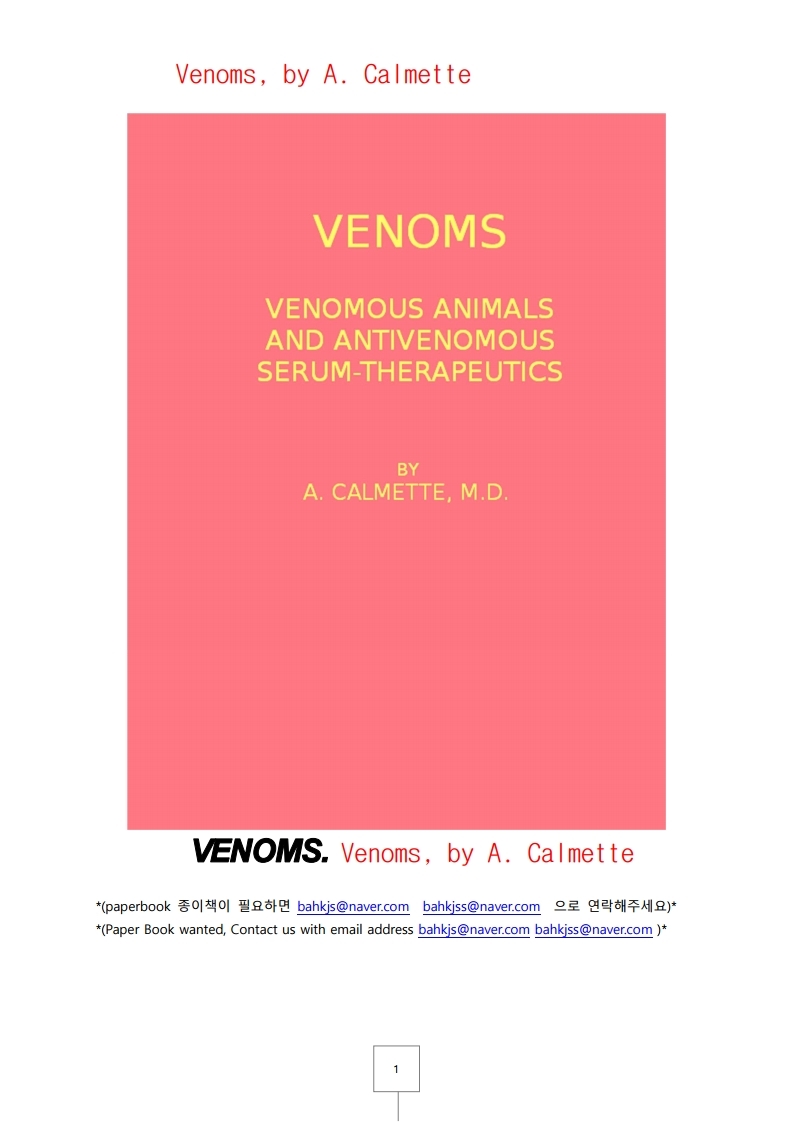TABLE OF CONTENTS.
PART I.
Page
CHAP. I.―I. General notes on poisonous animals 1
II. General classification of poisonous snakes. Their
anatomo- physiological characters 3
CHAP. II.― Habits of poisonous snakes. Their capture 17
CHAP. III.― Description of the principal species of poisonous
snakes. Their geographical distribution 22
A. Europe 22
B. Asia, Dutch Indies and Philippine Islands 30
C. Africa 57
D. Australia and adjacent large islands 81
E. America 100
F. Hydrophiidæ (sea- snakes) 131
G. Geographical distribution of the principal genera
of poisonous snakes in the five divisions of the
world 142
PART II.
CHAP. IV.― Secretion and collection of venom in snakes 147
CHAP. V.― Chemical study of snake- venoms 159
CHAP. VI.― Physiological action of snake- venoms 168
A. Physiology of poisoning in man and in animals 168
bitten by the different species of poisonous
snakes (Colubridæ, Viperidæ, Hydrophiidæ)
B. Physiology of experimental poisoning 170
C. Determination of the lethal doses of venom for
different species of animals 173
D. Effects of venom in non- lethal doses 177x
CHAP. VII.― Physiology of poisoning (continued). Effects of the
various venoms on the different tissues of the
organism 179
(1) Action upon the liver 182
(2) Action upon the kidney 183
(3) Action upon the spleen, heart and lungs 183
(4) Action upon the striated muscles 184
(5) Action upon the nervous centres 185
CHAP. VIII.― Physiology of poisoning (continued). Action of
venoms on the blood 188
A. Effects of venom on the coagulation of the blood 188
I. Coagulant venoms 190
II. Anticoagulant venoms 192
III. Mechanism of the anticoagulant action of
venoms on the blood 195
B. Effects of venom on the red corpuscles and on
the serum 196
(1) Hæmolysis 196
(2) Precipitins of venoms 202
(3) Agglutinins of venoms 202
C. Effects of venom upon the white corpuscles:
Leucolysin 203
CHAP. IX.― Physiology of poisoning (continued). Proteolytic,
cytolytic, bacteriolytic, and various diastasic
actions of venoms: diastasic and cellular actions
on venoms 204
A. Proteolytic action 204
B. Cytolytic action 206
C. Bacteriolytic action 206
D. Various diastasic actions of venoms 212
E. Action of various diastases upon venoms 214
CHAP. X.― Toxicity of the blood of venomous snakes 217
CHAP. XI.― Natural immunity of certain animals with respect to
snake- venoms 222
CHAP. XII.― Snake- charmers 228 xi
PART III.
ANTIVENOMOUS SERUM- THERAPEUTICS.
CHAP. XIII.― Vaccination against snake- venom―Preparation of
antivenomous serum―Its preventive properties
as regards intoxication by venom 241
Specificity and polyvalence of antivenomous serums 248
CHAP. XIV.― Neutralisation of venom by antitoxin 253
CHAP. XV.― Treatment of poisonous snake- bites in man and
animals. Objects of the treatment. Technique of
antivenomous serum- therapy 259
PART IV.
VENOMS IN THE ANIMAL SERIES.
CHAP. XVI.― Venoms in the animal series.
1.― Invertebrates 269
A. Cœlenterates 269
B. Echinoderms 273
C.
Arthrop
ods:
(a) Araneids
274
― (b) Scorpions 276
― (c) Myriopods 280
― (d) Insects 281
D. Molluscs 286
CHAP. XVII.― Venoms in the animal series (continued).
2.― Venomous fishes 288
A. Teleostei. Acanthopterygii:
―― 1. Triglidæ 290
―― 2. Trachinidæ 297
―― 3. Gobiidæ 300
―― 4. Teuthididæ 301
―― 5. Batrachiidæ 302
―― 6. Pediculati 303
B. Teleostei. Plectognathi: 305
C. Teleostei. Physostomi: 307
―― 1. Siluridæ 308
―― 2. Murænidæ 309 xii
CHAP. XVIII.― Venoms in the animal series (continued).
3.― Batrachians; Lizards; Mammals 312
A. Batrachians 312
B. Lizards 321
C. Mammals (Ornithorhynchus) 323
PART V.
DOCUMENTS.
도서소개
저자소개
목차소개





